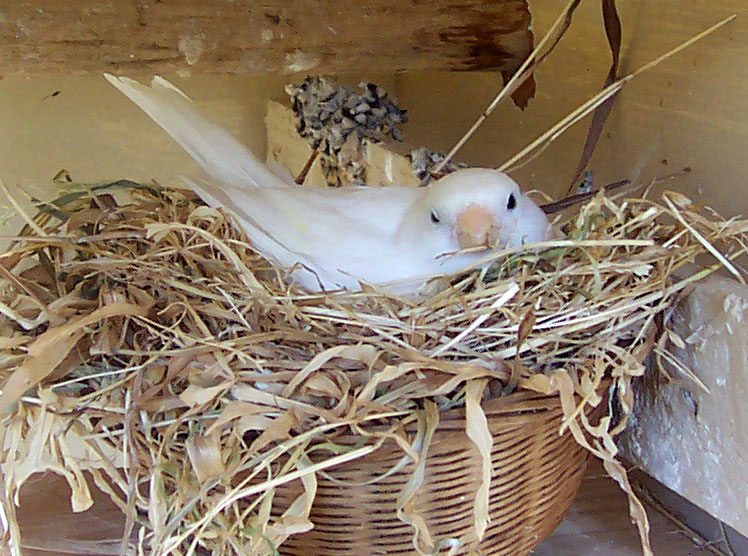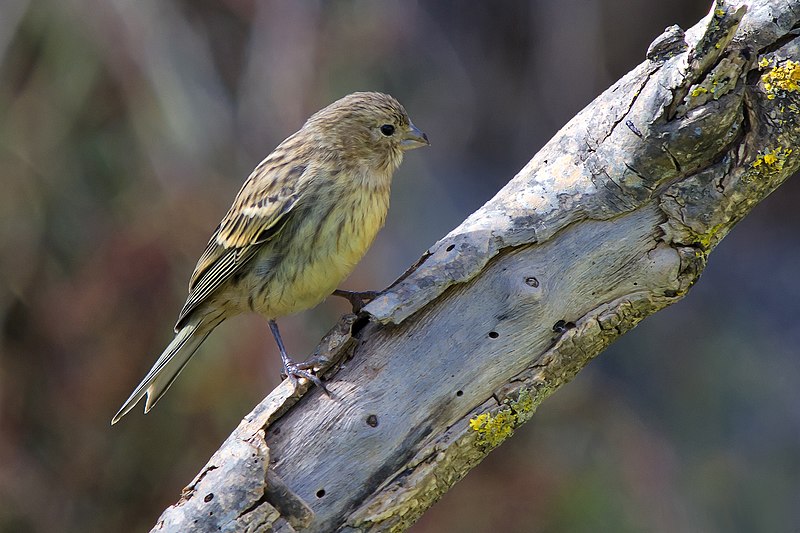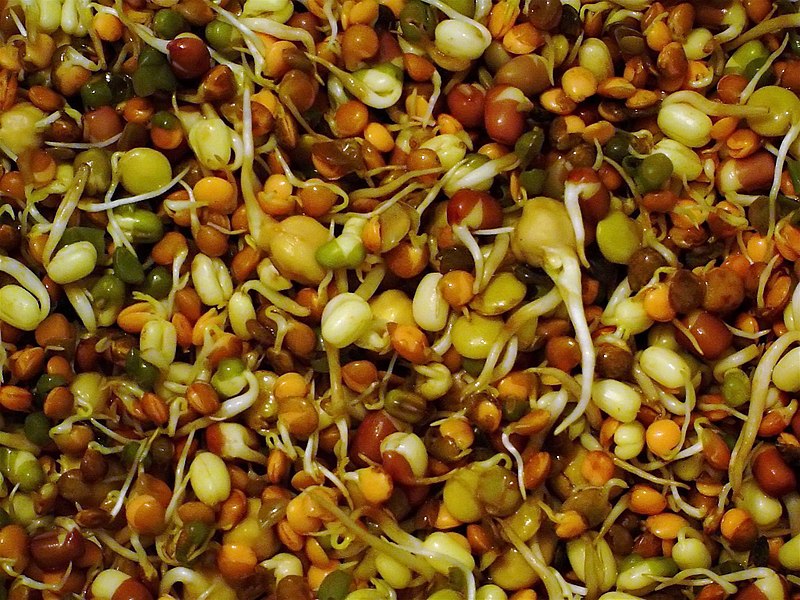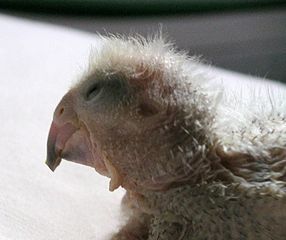 Whether they are hand or parent-reared, young Canaries usually need some encouragement to switch from the nestling to adult diet. This change-over period can be quite stressful, but there are a number of steps you can take to ease the transition.
Whether they are hand or parent-reared, young Canaries usually need some encouragement to switch from the nestling to adult diet. This change-over period can be quite stressful, but there are a number of steps you can take to ease the transition.
The Transition Period
Pet Canaries feed their chicks largely upon sprouts, soaked seeds and Egg Food or hard boiled eggs. Once the young fledge, which usually occurs at age 16-20 days, they will be fed by their parents for an additional 2 -3 weeks. During this time, they will also begin to pick at food and eventually learn to eat on their own. Fledglings benefit from watching their parents and siblings…chicks that are hand-reared are at a disadvantage in this respect, but will also respond to the ideas and foods mentioned below.
Hard seeds are a novel food for young Canaries, and acquiring the skill needed to open them takes practice. A high protein diet remains important right through the first molt (which usually begins within 2 months of fledging), but eventually seeds should replace egg-based foods as their staple.
Caution: Stress and Weight Loss
 While it is important to encourage youngsters to accept hard seeds, bear in mind that dietary switches, and the loss of parental care, are very stressful events. Stress can depress the immune system…if the birds are also losing weight, serious health problems can quickly take hold. So it’s important to keep them feeding, even if this means that the transition to adult foods will be slow. Continue to supply young birds with their favorites, such as egg food and sprouts, especially if they appear to be losing weight and slowing down. Canaries have little in the way of food reserves, so be sure to seek veterinary advice quickly if your birds decline in condition.
While it is important to encourage youngsters to accept hard seeds, bear in mind that dietary switches, and the loss of parental care, are very stressful events. Stress can depress the immune system…if the birds are also losing weight, serious health problems can quickly take hold. So it’s important to keep them feeding, even if this means that the transition to adult foods will be slow. Continue to supply young birds with their favorites, such as egg food and sprouts, especially if they appear to be losing weight and slowing down. Canaries have little in the way of food reserves, so be sure to seek veterinary advice quickly if your birds decline in condition.
Make all introductions gradually…even healthy foods may cause digestive upset if suddenly taken in large quantities. And, as most parents will tell you, mixing with favorite foods, and other trickery, is critical if any young “creature” is to accept a new diet!
Useful Weaning Foods and Techniques
Couscous soaked in hot water is used by many breeders as a transition food. I use soaked, crushed seeds in place of couscous, but several of my former coworkers at the Bronx Zoo report that Canaries eat it readily, and remain in good weight while adjusting to a seed-based diet. If you opt for couscous, I suggest that you offer soaked, ground seeds as well.
Crushed softbill pellets (i.e. Softbill Select) can be mixed into the foods that the youngsters are accustomed to (typically Egg Food or a similar product). This will provide additional nutrients and introduce new tastes.
 Seeds that are just beginning to sprout (please see photo, and article below for sprouting info) are one of the best foods to introduce. Most young Canaries relish sprouts; while pecking at the sprout the birds invariably hit the seed itself, and in time will begin to consume it as well.
Seeds that are just beginning to sprout (please see photo, and article below for sprouting info) are one of the best foods to introduce. Most young Canaries relish sprouts; while pecking at the sprout the birds invariably hit the seed itself, and in time will begin to consume it as well.
Mix some soaked seeds from your adult canary diet in among the sprouts to encourage further experimentation. Once your birds are eating softened seeds, add crushed or ground hard seeds. Coffee grinders or pestles can be used to break up seeds and render them easier to consume.
Further Reading
Video: Canary fledgling being fed by parent
Canary Nesting image referenced from wikipedia and originally posted by Fir0002
Juvenile Canary image referenced from wikipedia and originally posted by Juan Emilio
Mixed Bean Sprouts image referenced from wikipedia and originally posted by Atelier Joly
 That Bird Blog – Bird Care and History for Pet Birds
That Bird Blog – Bird Care and History for Pet Birds




Hello Frank!
It’s been quite a while, and I don’t know where to post this question… But here goes:
My aviary does not receive morning sunlight! It should since its outdoors, but the sun’s position has shifted and it receives none…
I tried installing some alternative sunlight: fluorescent lamp with 6500k (color spectrum of sunlight) but I fear its not enough, because its an energy saving lamp so it does not provide the warmth.
What if I add some light bulbs of 5500k (warm white) to generate heat near the bird’s perches? Like the ones used for incubation or breeders… Would that be good for them?
Because one of my beloved canary isn’t being her usual perky self these days, she looks a little bit “pale” so I put her back in a cage and gave her morning sun therapy…
Thanks…
Hello Ramond,
Thanks for your interest, nice to hear from you again.
Even without direct light, there will likely be some useful exposure to UVB/UVA radiation. Full spectrum bulbs designed for birds are available, but unless the aviary is completely shaded they may not be necessary.
If sudden changes are avoided and they are slowly acclimated, canaries can tolerate quite cold weather…breeders in the UK, s. Canada and elsewhere have wintered them outdoors with the aid of a heater shelter. A warm spot, as you suggest, is a good idea to be on the safe side, as ill or weak birds will do poorly if they cannot warm up. Ceramic heaters are preferable to lights; they can be run at night as the do not emit visible light. One or 2 can be used to establish a warm perch or warm area. The light cycle should follow that which is natural to your region…unnaturally-long daylight periods can cause out-of-season molting, egg-laying and other difficulties.
Unless you are an expert, I’d suggest consulting a licensed electrician befroe installing outdoor lights..many potential dangers.
Please let me know if you need any further information. Good luck, enjoy and please keep me posted.
Best regards, Frank Indiviglio.
Hi Frank, very helpful reply.
I don’t know what you mean by completely shaded, but it truly does not get the touch of direct sun. Although it is outdoor and sunlight still shines brightly on the unshaded areas. Does that still receive UV lights in any way?
I still intend to add in yellow light bulbs, the kind used to incubate baby birds.
But I was also thinking of maybe using reptilian basking lamp, the ones that provides UV lights… Though I wonder if birds and plants also benefits. Can they?
Thank you Frank. Hopefully the aviary will be well…
Hi Raymond,
Thanks, glad the info was useful. Studies of forest-dwelling reptiles indicate that UVA/B does seem to get through tree cover, but each situation is unique. There are UV meters available, but I haven’t checked if any are practical for home use.
Reptile UVB bulbs are designed to provide specific wavelengths of UVB (needed by some species to metabolize calcium), along with some UVA (not as well-studied). I believe most avian UV bulbs provide a wider spectrum, as may be useful to some birds, and so I would purchase those in preference to reptile bulbs. Any reptile or avian incandescent can be used for heat, as long as safe for outdoor use.
Mercury vapor bulbs provide heat and UVB/UVA, and do so over greater distances than others. They are designed for use with reptiles, but I believe provide a wide spectrum. They may be too strong (heat-wise) for summer use, however, and again, an electrician should be consulted re outdoor suitability.,
Best, Frank
Hello Frank,
I sent you an email with attached is a picture of my canary’s swollen foot.
a month ago she got cut and apparently since its not quite sterile, it develops into a swell.
when I touch that lump it feels like its filled with fluid…
She still has a good appetite and perky. But keeps one leg up…
So far I’ve given her a liquid remedy that promotes regeneration, mostly through her drinking water.
Should I give her antibiotics maybe? Or any other cure?
It pains me so much to see her like that.
Thank you Frank…
Hi Raymond,
Yes, the bird will need to be medicated; ideally it should be seen by a vet so that the bacteria can be identified, as not all respond to each antibiotic. Infections rarely if ever clear up without vet attention, and will eventually worsen, generally becoming fatal. I hope all goes well, pl keep me posted, best, Frank
Hi Frank,
I’m new at raising canaries, and would appreciate advice from someone as knowledgeable as you. 2 weeks ago 4 eggs hatched. Everything seemed fine until I noticed the stool left by either the male or female was different. It was a larger and softer stool than the previous times. A couple of days ago the female died in my hand. I can’t tell you how devastated I was, and still am. Thank goodness the male is feeding them. I am so worried about the babies maybe dying also. Today, I brought the stool sample to the Vet, he said there were traces of Gram Positive Cocci in the stool. I’ve done a little research online and found this is normal in pet birds. Please advice me in what to do. As you know, Vets are expensive, I’ve already spent quite a bit of money. Is there something I can do? Should I take them to the Vet for treatment or is it indeed normal for birds and not do anything at all. Please advise…..Thank you, Toni
Hi Tom,
It is common..many birds will carry it without ill effect until some other stress weakens the immune system; producing eggs and rearing chicks is one such stress. Coccidiosis is treatable, but if the male is not showing symptoms it would probably be best to leave him as is for now; perhaps test after the chicks are independent. The male may be able to raise them on his own…provide him with lots of food as described in this article and prepare in advance to wean the chicks onto an adult diet once they fledge. The link to the egg food mentioned in the article is not working…please use this link if need be. Good luck, and please keep me posted, best, Frank
Hello,
I read your above article, but I am experience many problems with my two canary babies. I will have to explain why I am hand rearing in the first place with my two chicks.
The 8 week old, I found one morning hanging upside down from his nest in the aviary. His foot had become tangled in some nesting material. He was about 2 weeks old then and he was very ill. He had bloody bruises on his neck and head, and one ear had a little blood coming out. He was very cold and extremely close to death. I brought him in the house, warmed him up and gave him some glucose water and after a couple of hours I had him eating from a syringe. He has been doing so ever since, except the last couple of days he has been taking slow less formula and still not even trying to eat the many things I have in the cage for him. He has lost weight a little and I am forcing him to eat, but he is making it difficult. I don’t want him to die after all he has been through and the great recovery he made. By the way his name is Felix.
Then about 3 weeks ago I went out to aviary in the mornings, as I always do and found one of the mother canaries dead in her nest, I can’t explain why except she was getting up there in years and she seemed totally fine the day before. She had two babies and one was still alive. The one that died was the smaller of the two and it looked like it probably couldn’t breath, when the mother died on top of it. I brought the survivor in and although it was weak, it took the glucose water and eventually ate. It did not eat like Felix and would nibble the food off the tip of the syringe and not let me put it in its mouth. Although it only nibbled its crop would fill up, with very little air bubbles and it became stronger and stronger. We named her Nibbler and now she is about 6 weeks old. She is still feeding from the syringe fine.
Felix and Nibbler live in the same cage and I have been giving them spouted seed, boiled egg, fruit and greens from the garden everyday. They also have fresh water, seed and egg food at all times.
They both will nibble on a seed or two, but stop. There has been no interest in the sprouted seed or fruit or greens and they may take a bite or two of the egg and thats it.
Could I introduce a young healthy female to the cage, to teach them what canaries are suppose to do? I would put Dad in, but he has his wings full at the moment feeding around 8 fledglings and all the other males are to young and wouldn’t have a clue what to do.
Is there anything else I can try, because I pretty well covered everything you mentioned above to do?
I love these little guys and I have worked hard to keep them feed and clean all these weeks. I even made them a travel box and they would come everywhere with me. I bought a battery operated baby bottle warmer to keep their formula warm and ready to eat, when I was out.
It is summer here in Australia, so I didn’t have to keep them warm and at night their little nest had a heat pad under it to keep them warm while they slept.
Please help!!!
From and extremely desperate canary foster mother
Hi Martha,
My compliments on your efforts. You are doing everything properly as far as I can see…unfortunately, it can take a long time and not all birds make the transition very well. I think that introducing a non-breeding female would be risky…but if you watch carefully (as I’m certain you will!) it may be worth trying. Sorry I could not be of more help, please keep me posted, Frank
Hi my good friend
I am interested in the birds of Iran
For years I feed the pigeons and canaries
I know very well the life cycle Canary
But
I have several gold finches
But they are not ready to mate my birds singing!
I saloons, moisture, light and good nutrition
You know a way to increase the breeding or singing?
Some recommend to Tsttrvn and hormones!
Do you agree?
Please reply on my blog
Hello,
I apologize for the delay…missed your comment due to a system glitch.
I don’t recommend hormones…captive conditions change their behavior (due to differences in light cycle, diet etc) and hormones complicate this. Best to expose them to a natural day/night cycle and to increase the feeding of fresh greens and perhaps some insects or other protein based food (hard boiled egg). Please keep me posted, enjoy, Frank
thanks a lot for answer
My pleasure….I hope all goes well,
Best regards, Frank
Hello Frank, it’s me again. I started with 6pairs of zebra finches(ready for breeding) and a couple of 4 month old canaries(engendered) today. I need a second opinion aside from the breeder’s. My question is 1. Do I need to put the every pair of zebra finches in a separate cages to breed or I should settle for colony cage?
2. Do I need to separate the couple of canaries in a separate cage too? or is it okay that they remain in a same cage?
Hoping to hear from you soon Frank!
More power!
Sincerely,
Barry
Hello Barry,
Nice to hear form you. Zebra Finches will do well and breed as a colony in a large cage..always some potential for trouble…one female hogging all the eggs,, etc., but in general they do fine. Young canaries can be kept together for a few more months, but best to separate pairs until breeding season; 2 mature males will likely fight. Please keep me posted, enjoy, Frank